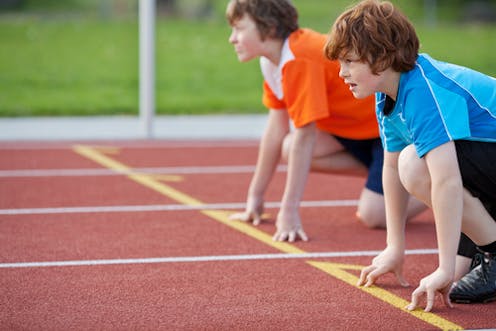Kids' fitness is improving, but they still aren't as fit as their parents were
Kids' fitness has declined for several decades, but kids in rich countries are showing improvement. What does this suggest for kids in poor countries?

Physical fitness is important for success in sports and athletics, but it is also important for good health. If you are generally fit, you probably have a strong heart, brain, muscles and bones, all of which help you to exercise and improve your chances of living a long, fit and healthy life.
The most important type of fitness for good health is aerobic fitness, which is your ability to exercise or be physically active at a constant pace for a long period of time (say, more than 20 minutes), such as running, walking, biking, swimming, rowing, or playing aerobic sports such as soccer or basketball.
Monitoring national and international trends in kids’ aerobic fitness is important to understand trends in the underlying current and potential future health of a population. Research shows that if you are aerobically fit as an adult, then you are less likely to develop or die from chronic conditions such as heart disease, stroke and some cancers. And, if you were fit as a kid, then you are more likely to be a fit and healthy as an adult.
Take a second to think about your own fitness level. Do you think you were as fit as today’s kids when you were their age?
This has been a topic of much discussion in recent decades. Most people say that kids’ fitness has declined, some say that it has not changed at all, while few are willing to say that it has improved.
To help settle this debate, our research team has spent the past two decades gathering historical fitness data on millions of kids from around the world.
Improvements in some kids
We systematically analyzed decades of data from hundreds of studies across many different countries to compare the aerobic fitness of kids of the same age and gender, all measured using the same fitness tests.
In 2003, our research was the first to conclusively show that kids’ aerobic fitness did in fact decline around the world at the end of the 20th century. In our very large study of 25 million kids aged 6 to 19 years from 27 countries, we showed that aerobic fitness declined worldwide between 1970 and 2000, with kids in 2000 about 15 percent less fit than their parents were when they were kids.
Yet there is some good news suggesting that kids’ fitness levels may no longer be on the slide. We recently published an update to our 2003 study in the British Journal of Sports Medicine, which examined trends in the aerobic fitness levels of 1 million kids aged 9 to 17 years from 19 high-income (such as Australia, Canada, the United States, etc.) and upper middle-income (such as Brazil and South Africa) countries between 1981 and 2014. We measured aerobic fitness using the 20-meter shuttle run, also called the “beep” test, or the PACER test.
The beep test is the world’s most popular field test of aerobic fitness for kids. It is a progressive exercise test involving continuous running between two lines 20 meters (66 feet) apart in time to recorded beeps. The time between beeps gets progressively shorter, and the test is over when you can no longer run the 20-meter distance before the audio beep.
Our updated study confirmed that kids’ aerobic fitness levels had in fact declined in the 1980s and 1990s, but interestingly, the decline appears to have slowed since 2000 with fitness levels plateauing over the past decade.

While trends in fitness differed between countries, most showed overall declines. After 2000, however, aerobic fitness improved in Brazil and Japan; plateaued in Australia, Canada, Greece, South Africa and Spain; and declined in Portugal, the United Kingdom and the United States. Today’s kids are still less fit than their parents were when they were kids, but the gap is about half as much as previously thought — and now about 7 percent.
What’s the cause?
We explored links between trends in aerobic fitness and trends in broad socioeconomic and health factors in each country, including income inequality, physical activity levels, and overweight and obesity levels.
The strongest indicator of a country’s fitness level was the gap between rich and poor, as measured by the Gini Index. Countries with a widening gap between the rich and poor experienced the largest declines in aerobic fitness between 2000 and 2014.
Countries with a widening gap between rich and poor tend to have a growing number of poor people. Poverty is linked to poor social and health outcomes in high- and upper-middle income countries, known as the social determinants of health. An indirect result of poverty could be a lack of opportunities, time and resources to be physically active and to participate in activities that improve or maintain an individual’s aerobic fitness level.
Assuming this link is causal, policies that tackle income inequalities and build on improving the social determinants of health within countries could lead to improved aerobic fitness levels to not only stem the declining fitness tide, but to turn the fitness tide around for good for people of all ages.
The authors do not work for, consult, own shares in or receive funding from any company or organization that would benefit from this article, and have disclosed no relevant affiliations beyond their academic appointment.
Read These Next
RFK Jr. wants to scrutinize the vaccine schedule – but its safety record is already decades long
Federal officials are questioning the safety of the vaccine series children receive. Here’s the story…
Resolve to stop punching the clock: Why you might be able to change when and how long you work
Thinking about what makes work worth doing and what you would do with your time if you weren’t spending…
What are gas stove manufacturers trying to hide? Warning labels
The gas industry is opposed to labels that warn consumers of the potential harms of gas stoves.






